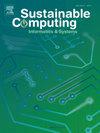通过动态数字孪生模型和深度学习实现节能智能电网运行
IF 5.7
3区 计算机科学
Q1 COMPUTER SCIENCE, HARDWARE & ARCHITECTURE
引用次数: 0
摘要
在智能电网配电网中采用动态数字孪生(DDT)模型是实现先进动态能源管理与控制的革命性突破。然而,即使是最先进的系统也不能充分描述静态体系结构配置,或者它们不能在这个过程中提供足够的自动化,它们不能处理动态交互或拓扑层次结构。为了克服这些限制,本研究提出了一种基于图神经网络(gnn)构建DDT模型的新框架。当涉及到对图结构数据的建模时,gnn优于其他深度学习模型,这在智能电网的节点和边缘建模中有应用。所采用的模型扩展了关键技术参数的成果,表明稳压效率为92 %,网络效率为95 %;因此,功率分配和运行可靠性被认为是最优的。电压分布偏差0.015 p.u.和功率损耗降低18.3 %也反映了这些发现的优势,这表明所提出的方法比现有的静态模型具有更好的电压分布稳定性和更少的能量损失。通过在MATLAB Simulink和基于python的库(如PyTorch Geometric)中进行实验,可以证明该框架的实用性和适用性。该研究为解决应用研究中的问题提供了一种新的方法,并为智能电网中现实数字孪生应用的进一步发展提供了基础。本文章由计算机程序翻译,如有差异,请以英文原文为准。
Energy-efficient smart grid operations through dynamic digital twin models and deep learning
Adopting the dynamic digital twin (DDT) model in smart grid distribution networks is a revolutionary breakthrough toward advanced dynamic energy management and control. However, even the most advanced systems fail to describe static architectural configuration adequately or they do not offer sufficient automation in this process, they are unable to handle dynamic interactions or topological hierarchy. To overcome such restrictions, this research presents a new framework for building DDT models based on Graph Neural Networks (GNNs). GNNs outperform other deep learning models when it comes to modeling graph-structured data which has application in modeling nodes and edges of smart grids. The adopted model expands the critical technical parameters' achievements and indicates a high Voltage Regulation Efficiency of 92 % and Network Efficiency belonging to 95 %; therefore, the distribution of power and operation reliability is considered optimal. The advantage of these findings is also echoed by the Voltage Profile Deviation of 0.015 p.u. and the Power Loss Reduction of 18.3 % which suggest that the proposed method offers better voltage profile stability and less energy losses than existing static models. The usefulness and applicability of the framework can be shown by performing experiments in MATLAB Simulink and Python-based libraries such as PyTorch Geometric. This study provides a novel approach to address issues in applied research and provides the basis for further advancements in realistic digital twin applications concerning smart grids.
求助全文
通过发布文献求助,成功后即可免费获取论文全文。
去求助
来源期刊

Sustainable Computing-Informatics & Systems
COMPUTER SCIENCE, HARDWARE & ARCHITECTUREC-COMPUTER SCIENCE, INFORMATION SYSTEMS
CiteScore
10.70
自引率
4.40%
发文量
142
期刊介绍:
Sustainable computing is a rapidly expanding research area spanning the fields of computer science and engineering, electrical engineering as well as other engineering disciplines. The aim of Sustainable Computing: Informatics and Systems (SUSCOM) is to publish the myriad research findings related to energy-aware and thermal-aware management of computing resource. Equally important is a spectrum of related research issues such as applications of computing that can have ecological and societal impacts. SUSCOM publishes original and timely research papers and survey articles in current areas of power, energy, temperature, and environment related research areas of current importance to readers. SUSCOM has an editorial board comprising prominent researchers from around the world and selects competitively evaluated peer-reviewed papers.
 求助内容:
求助内容: 应助结果提醒方式:
应助结果提醒方式:


